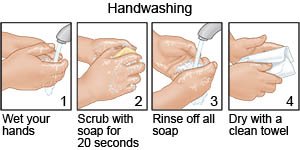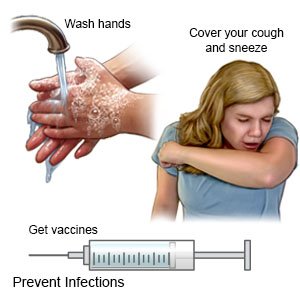Measles in Adults
Medically reviewed by Drugs.com. Last updated on May 6, 2024.
What is measles?
Measles is a disease caused by a virus. It is usually prevented by a vaccine given in childhood. Your risk for measles is high if you did not get some or all of the recommended vaccine doses. Measles can cause serious health problems, such as pneumonia or encephalitis (brain swelling). Your risk for problems is higher if you are 20 years or older, pregnant, or have a weak immune system. Some nutrition problems, such as a lack of vitamin A, can also increase your risk.
What do I need to know about how the measles virus spreads?
Measles is highly contagious (easily spread from one person to another). The virus is in an infected person's nose and throat while he or she is sick with measles.
- The virus spreads through droplets when an infected person coughs or sneezes. It can stay in the air for up to 2 hours. Another person can become infected by breathing in the infected droplets.
- The virus can stay on a surface or object it lands on. Anyone who touches the surface or object and then touches his or her mouth or eyes can be infected.
- An infected person can pass the virus to others 4 days before and up to 4 days after a rash appears.
- A person with a weak immune system can pass the virus at any time until he or she is well.
What are the signs and symptoms of measles?
You may develop a rash about 10 to 14 days after you are exposed to the virus. The rash usually begins on the face and head and then spreads down to the legs and feet. It may first appear as tiny spots that later join to make large patchy bumps. The rash usually disappears in 5 to 8 days. Your skin may peel afterward. You may also have any of the following:
- A high fever that starts when the rash appears
- A cough, runny nose, sore throat, and muscle aches
- Red, irritated eyes that are watery and sensitive to light
- Small white spots that appear in 2 to 3 days inside your mouth, usually on the cheeks
- Abdominal pain, vomiting, or diarrhea
How is measles diagnosed?
Your healthcare provider may be able to diagnose measles based on your symptoms and a physical exam. You may need a blood test to confirm the infection.
What can I do to manage my symptoms?
No treatment is available for measles. The following may help relieve your symptoms:
- Get more rest. Rest as much as possible and get plenty of sleep.
- Drink liquids as directed. Liquids help prevent dehydration. Ask how much liquid to drink each day. Drink water, juice, or broth instead of sports drinks. You may also need an oral rehydration solution (ORS). An ORS has the right amounts of water, salts, and sugar you need to replace body fluids. Ask your healthcare provider where you can get an ORS.
- Eat soft foods. These include cooked cereal, rice, mashed potatoes, applesauce, or soup. Do not eat foods that are sour or hard to chew. This can increase saliva and make your pain worse.
- Protect your eyes, if necessary. Keep the lights dim or wear sunglasses if you have sensitivity to light. This will help decrease eye discomfort.
- Acetaminophen decreases pain and fever. It is available without a doctor's order. Ask how much to take and how often to take it. Follow directions. Read the labels of all other medicines you are using to see if they also contain acetaminophen, or ask your doctor or pharmacist. Acetaminophen can cause liver damage if not taken correctly.
- NSAIDs help decrease swelling and pain or fever. This medicine is available with or without a doctor's order. NSAIDs can cause stomach bleeding or kidney problems in certain people. If you take blood thinner medicine, always ask your healthcare provider if NSAIDs are safe for you. Always read the medicine label and follow directions.
- Cough medicine helps decrease the urge to cough and may help you rest.
Treatment options
The following list of medications are related to or used in the treatment of this condition.
What can I do to prevent measles?
- Ask your healthcare provider about the MMR vaccine. This vaccine helps protect you and others around you from measles, mumps, and rubella. The MMR vaccine is usually given to children, but you can still get it as an adult. Tell your provider if you did not receive the vaccine as a child, or you did not receive all doses. Tell him or her if you do not know your vaccine history. Your provider will tell you if you should get the vaccine. He or she will tell you when to get the vaccine, and how many doses you need.
- Prevent the spread of the measles virus. You can spread the virus 4 days before and up to 4 days after a rash appears. The following can help you prevent the virus from spreading:
- Wash your hands often. Wash your hands several times each day. Wash after you use the bathroom, change a child's diaper, and before you prepare or eat food. Use soap and water every time. Rub your soapy hands together, lacing your fingers. Wash the front and back of your hands, and in between your fingers. Use the fingers of one hand to scrub under the fingernails of the other hand. Wash for at least 20 seconds. Rinse with warm, running water for several seconds. Then dry your hands with a clean towel or paper towel. Use hand sanitizer that contains alcohol if soap and water are not available. Do not touch your eyes, nose, or mouth without washing your hands first.

- Stay away from others, especially anyone who is pregnant or has not had the MMR vaccine. Stay home from school or work until your healthcare provider says you can return.
- Do not share items. Do not share dishes, towels, or other items with anyone. Items need to be washed after you use them.
- Clean surfaces often. Use a disinfecting wipe, a single-use sponge, or a cloth you can wash and reuse. Use disinfecting cleaners if you do not have wipes. You can create a disinfecting cleaner by mixing 1 part bleach with 10 parts water. In the kitchen, clean countertops, cooking surfaces, and the fronts and insides of the microwave and refrigerator. In the bathroom, clean the toilet, the area around the toilet, the sink, the area around the sink, and faucets. Clean surfaces in the person's room, such as a desk or dresser.
- Cover a sneeze or cough. Use a tissue that covers your mouth and nose. Throw the tissue away in a trash can right away. Use the bend of your arm if a tissue is not available. Then wash your hands well with soap and water or use a hand sanitizer. Do not stand close to anyone who is sneezing or coughing.

- Wash your hands often. Wash your hands several times each day. Wash after you use the bathroom, change a child's diaper, and before you prepare or eat food. Use soap and water every time. Rub your soapy hands together, lacing your fingers. Wash the front and back of your hands, and in between your fingers. Use the fingers of one hand to scrub under the fingernails of the other hand. Wash for at least 20 seconds. Rinse with warm, running water for several seconds. Then dry your hands with a clean towel or paper towel. Use hand sanitizer that contains alcohol if soap and water are not available. Do not touch your eyes, nose, or mouth without washing your hands first.
Call your local emergency number (911 in the US) if:
- You have a seizure.
When should I seek immediate care?
- You have trouble breathing or are breathing faster than usual.
- You have a headache, drowsiness, and a stiff neck.
- You are confused or less alert than usual.
When should I call my doctor?
- Your cough lasts for more than 4 days.
- You cough up thick mucus.
- You have an earache.
- Anyone in your household develops a rash.
- You have questions or concerns about your condition or care.
Care Agreement
You have the right to help plan your care. Learn about your health condition and how it may be treated. Discuss treatment options with your healthcare providers to decide what care you want to receive. You always have the right to refuse treatment. The above information is an educational aid only. It is not intended as medical advice for individual conditions or treatments. Talk to your doctor, nurse or pharmacist before following any medical regimen to see if it is safe and effective for you.© Copyright Merative 2024 Information is for End User's use only and may not be sold, redistributed or otherwise used for commercial purposes.
Learn more about Measles
Treatment options
Symptoms and treatments
Further information
Always consult your healthcare provider to ensure the information displayed on this page applies to your personal circumstances.
